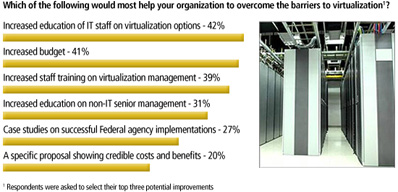The 2009 federal virtualization report
CDW Government released its 2009 Federal Virtualization Report, an assessment of client, server and storage virtualization in Federal civilian and defense agencies. The report, based on an April survey of 377 Federal IT managers, reveals that while 73 percent say the technique, a broad term used to describe the abstraction of computer resources, is integral to improved efficiency in IT operations and reduced costs, just 20 percent indicate that their agencies are harnessing virtualization to the fullest extent.

Seventy-nine percent of respondents indicated that their agency has begun implementation of some form of virtualization. Despite this broad adoption of virtualization technologies, just 50 percent of the same IT managers reported that their implementation has been successful. Respondents cited the lack of front-end funding to capture the larger – but downstream – benefits as the single largest obstacle to greater success.
The report examines the state of Federal virtualization, identifies obstacles to broader adoption and outlines steps to overcome the obstacles. Fifty-nine percent of Federal agencies have implemented server virtualization, a method of running multiple independent server operating systems on a single physical server.
More than half of Federal agencies (51 percent) are also utilizing storage virtualization, a method of making many different physical storage networks and devices appear as one entity for purposes of management and administration. Forty-nine percent of agencies have implemented client virtualization, a method of running multiple desktops and/or applications centrally in the data center.
Federal IT managers cited many benefits of virtualization, including reduced capital and operating costs, improved continuity of operations, improved network security and better utilization and capacity management of computing resources.
Beyond budget, Federal IT managers also cited education and training as key to virtualization success. Of those who said their IT department is appropriately staffed and trained to migrate to and manage a virtualized environment, 67 percent described their virtualization implementation as successful, compared to just 22 percent of those in organizations where the IT department is not fully trained. CIO knowledge is also essential to virtualization success, the survey found. Of those respondents who gave their CIO an A or B grade for virtualization proficiency, 62 percent said their agency successfully implemented a virtualized environment, compared to 34 percent of respondents who gave their CIO a C, D or F.
To ensure virtualization success, IT managers called for increased education of IT staff on virtualization options (42 percent), followed by increased budget (41 percent) and increased staff training on virtualization management (39 percent).
Based upon the findings, CDW-G recommends that Federal agencies:
- Share best practices with other agencies and private-sector peers
- Become intimately familiar with the agency IT budget in order to accurately project virtualization return on investment
- Secure CIO and other senior executive buy-in; encourage CIO virtualization proficiency
- Audit training needs and implement programs for rank-and-file and executive staff. Task subject matter experts with staying abreast of virtualization advances
- Select and track metrics to ensure virtualization delivers against goals.